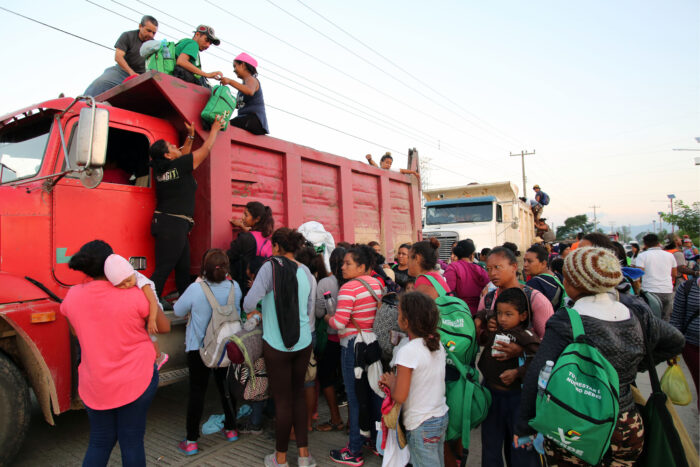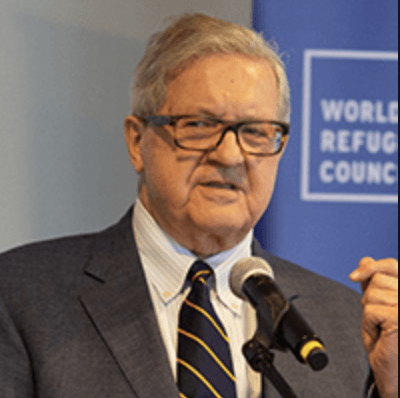WRMC Chair Lloyd Axworthy and special advisor Allan Rock make the case as to how Canada can ease the refugee crisis at the U.S.-Mexican border.
This article was originally published in the Globe and Mail.
Along the southern border of the United States, the intense heat of summer usually reduces the number of migrants seeking asylum. But not this year. The New York Times reported that border officials encountered migrants nearly 6,000 times a day during June for a total of more than 188,000 – the largest monthly number in recent history.
Sadly, that is not the only place where records are being set for levels of displacement. Worldwide, there were over 82 million people forcibly displaced at the end of 2020 – an all-time high – driven from their homes by persecution, conflict, violence and the ravages of climate change.
Three-quarters of all refugees end up in neighbouring countries: from South Sudan to Uganda, Myanmar to Bangladesh, Venezuela to Colombia and so on. In a way, it’s only natural. But it isn’t right, or fair. The result is that 86 per cent of refugees are in developing countries – the ones least able to accommodate, house, feed and protect them.
The surge of migrants is occurring at a time when less and less attention is being paid to their plight. The focus in the so-called overdeveloped world is on the COVID-19 pandemic, protecting our public health and the prospects for our recovering economies. The concept of sharing seems to have disappeared from the international lexicon.
Yet responsibility sharing is the key ingredient in any effective response to global displacement. That is why it was the cornerstone of the 2019 report of the World Refugee and Migration Council (WRMC), A Call to Action. The report emphasized that the ancient duty to grant asylum is universal, to be shared among the world’s nations.
Proximity alone should not determine the place of refuge, and neighbouring countries should not be the only alternative for those forced to flee. We called for a “common but differentiated” responsibility: It may not be practical to expect every country to admit significant numbers of refugees. But those that do not must contribute to the shared effort in other ways, including financially.
That principle has direct application here in our hemisphere. The situation on America’s southern border represents a continental crisis that demands a continental response. If responsibility sharing is to have any meaning, then the nations of the region – including Canada – must step forward and accept their role in forging solutions.
And not just governments can come up with good ideas. We need to build a constellation of international players working in networks to identify solutions and promote the adoption of them. One strategy to counter the reactionaries who want to return to might-is-right behaviour is to reconfigure the way a global system can be organized to enable more flexible arrangements, coalitions and networks that draw together the constructive actors in our global community.
In that very spirit, the WRMC led the creation of the North and Central American Task Force on Migration to brainstorm and then advocate for enlightened approaches. Task force co-chairs are former foreign ministers and senior officials from across North and South America and its members include academics, people from civil society, business leaders and former policy-makers.
The first set of practical, evidence-based recommendations from the task force has now been published, setting out concrete measures needed to respond to urgent humanitarian needs among asylum seekers at the southern U.S. border – especially the protection of women and girls. Recommendations on other key subjects will follow in the months ahead.
To be clear, these are not simply recommendations about how the United States can improve the conditions endured by the asylum seekers. Rather, the proposals speak to the roles of all nations in the region, and how each of us can contribute to addressing the crisis. Because all regional authorities have a role to play.
Canada can take the lead – and help U.S. President Joe Biden manage one of his thorniest political problems – by convening an urgent meeting between its leaders and those from the U.S. and Mexico, with migration issues heading the agenda and Central American leaders also in attendance. The meeting should explore regional responses to address the pressure at the southern U.S. border, protect the displaced and open new pathways toward their orderly resettlement.
That can include cancelling the flawed Safe Third Country Agreement between Canada and the U.S. And Canada should receive our share of asylum seekers from Central America as part of Immigration Minister Marco Mendicino’s welcome initiative to increase the overall number of refugees we resettle.
In short, by sharing responsibility and showing leadership, Canada can help a neighbour manage a crisis while working with regional partners to find effective ways to address urgent humanitarian needs.

